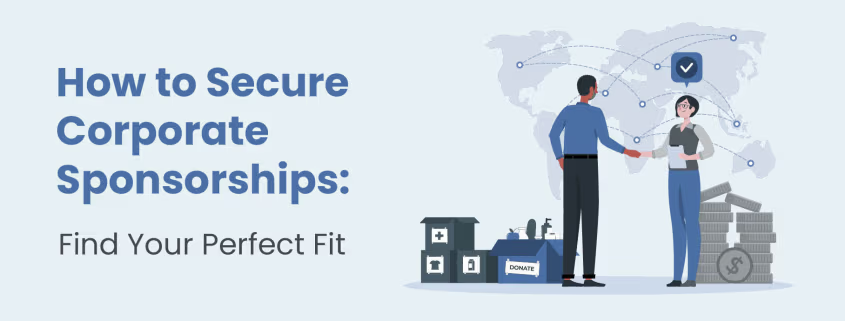How to Secure Corporate Sponsorships: Find Your Perfect Fit
Businesses everywhere devote time and energy to making a positive impact through corporate citizenship. Often, they do this by supporting nonprofits! If your organization is looking for extra support, corporate philanthropy efforts like sponsorships are a major opportunity to cash in on.
In this guide, we’ll cover everything you need to know to find and secure the perfect corporate sponsorships for your organization, including:
- What are Corporate Sponsorships for Nonprofits?
- Benefits of Corporate Sponsorships
- Finding Your Perfect Corporate Sponsorship Match
- How to Get Corporate Sponsors: 7 Steps
- Corporate Sponsorship Examples
Along with sponsorships, you can expand your strategy further by tapping into other corporate giving opportunities, like matching gifts, volunteer grants, and more. Let’s dive in so you can start building powerful corporate partnerships!
What are Corporate Sponorships for Nonprofits?
Corporate sponsorships refer to the direct support companies give to nonprofits. Usually, a sponsorship is an agreement to fund a specific project, program, or event. Often, the two parties come to a mutually beneficial agreement where the company provides funding for the nonprofit and the nonprofit promotes the company in its marketing.
However, successful corporate sponsorships don’t always look the same. A business’s support can take multiple different forms, including:
- Financial: The most common type of sponsorship is when companies donate a large sum of money for a specific purpose. This might be to fund an event, purchase new technology, or launch a mission-relevant program.
- In-Kind: Some businesses opt to donate goods or services instead of money. For instance, a company might give your nonprofit event supplies, like auction prizes, or professional services, like legal counseling.
- Media: Don’t have much marketing experience? A business can provide a media sponsorship with free promotional materials, advertising space, or other marketing services, such as professional graphic design support. Some may even go as far as to promote your nonprofit directly to their customers.
Keep in mind that sponsorships are often only one part of a company’s overall corporate social responsibility (CSR) strategy. Many companies also have workplace giving programs that let their employees play a role in determining where the company donates. This means even if you don’t secure a sponsorship with a company, you might still get support from them.
For instance, a business may offer its employees matching gifts to double their donations to hundreds of nonprofits year-round. Many of your donors likely work for companies that offer these programs, meaning you may be able to earn corporate support now!
Benefits of Corporate Sponsorships
When a business’s goals align with your nonprofit’s, both you and the company sponsoring your organization benefit. Let’s take a look at what these benefits look like from both perspectives:
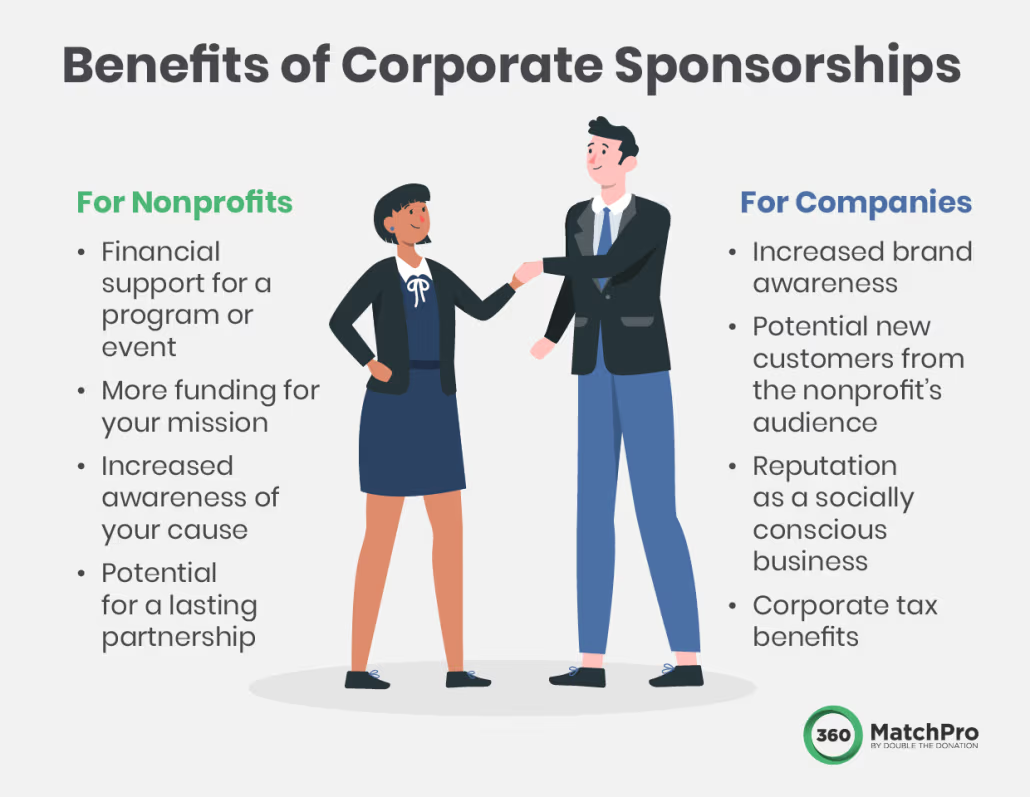
For Nonprofits
Depending on your needs and the type of corporate sponsorship you secure, your nonprofit could receive:
- Financial support for a program or event. Sponsorships usually provide a massive lump sum, allowing your nonprofit to launch a major program, fundraiser, or event that you might not be able to otherwise fund with regular donations alone.
- More funding for your mission. Whether your sponsor provides direct funding, supports an event, or increases your marketing opportunities, additional funding powers your mission and takes the pressure off of your budget.
- Increased awareness of your cause. Corporate sponsorships market your nonprofit’s cause to a new audience: the business’s customers. If your sponsor’s audience is interested in your work, you could acquire a slew of new donors!
- Potential for a lasting partnership. If you and your sponsor develop a strong relationship, they may be open to supporting your organization again in the future. This could include providing additional sponsorships, encouraging employees to volunteer, or even creating a custom matching gift program that applies only to your nonprofit.
For Companies
Meanwhile, your corporate sponsor can benefit from:
- Increased brand awareness. A key part of many sponsorship agreements is that the nonprofit adds the sponsor’s name and logo to marketing materials, signage, and event merchandise. The company’s customers who see these materials will be eager to continue doing business with them, increasing customer loyalty.
- Potential new customers from your nonprofit’s audience. When your supporters see the company’s logo and learn that they funded your nonprofit’s event or program, they may decide to shop at your sponsor’s business.
- A reputation as a socially conscious company. Businesses that regularly participate in public CSR initiatives are seen more favorably in the public eye. Philanthropy efforts like corporate sponsorships can even motivate employees by cultivating trust and instilling their work with a sense of purpose.
- Tax benefits. Just like individual donors can get charitable tax deductions for their contributions, so can companies.
Altogether, these benefits make any corporate sponsorship a win-win with the potential for lasting, positive impacts for everyone involved.
Finding Your Perfect Corporate Sponsorship Match
Excited to seek out a corporate sponsorship for your organization? Start the process by researching businesses that could be interested and willing to support your nonprofit.
Use the following strategies to find a company that could be the perfect match for your nonprofit:
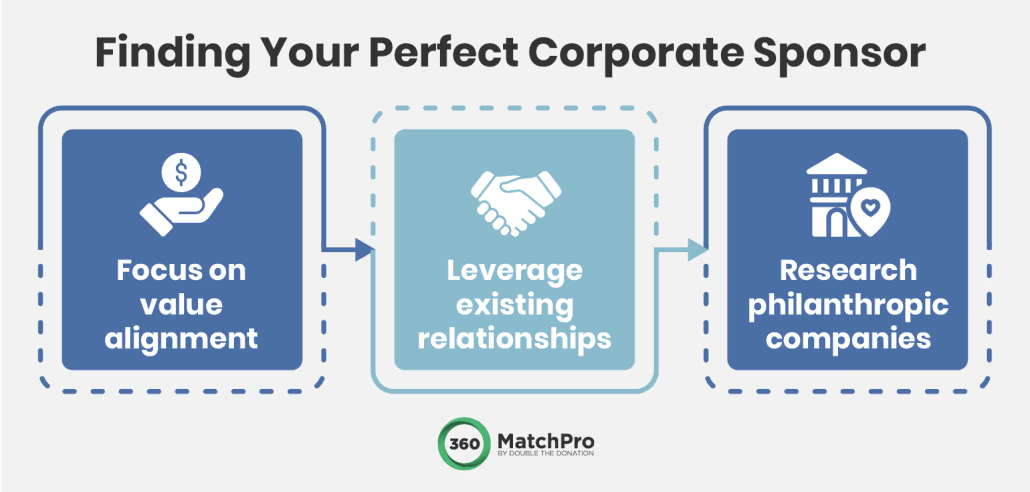
Focus on Value Alignment
Your ideal corporate sponsor should have a genuine interest in your cause. If their values align with yours, they’ll be more likely to partner with your nonprofit. Additionally, businesses that share your values likely have customers and employees with similar values and charitable interests. This means more prospective donors for your nonprofit.
To find companies with values that align with yours, assess corporations’ audiences and product and service offerings. For instance, an animal shelter should research pet supply stores and dog grooming businesses, knowing these businesses’ customers likely value animals as much as you do.
Leverage Existing Relationships
It’s easier to secure corporate sponsorships if your organization already has a connection with the business. Existing relationships make setting up introductions easier, which allows you to show businesses’ decision-makers that your nonprofit’s cause aligns with their interests.
Your nonprofit likely already has more connections to business than you might realize. For instance, any of these connections could help you get your foot in the door:
- Previous partnerships with a company
- Employees who have donated to your nonprofit
- Board members who work for or with the business
- Businesses that operate in the same local community
If you can show prospective sponsors that your nonprofit is already connected to their business and that they’ll benefit from a well-aligned partnership, they’ll be more likely to sponsor you.
Research Philanthropic Companies
The final piece that makes a business a perfect potential corporate sponsor is an established habit of giving. If a company has a clear philanthropic history, they are likely to continue giving in the future!
Search for companies that have publicly donated to nonprofits and those with robust CSR programs that include sponsorships. Lists of top matching gift and volunteer grant companies can be a good place to start.
Plus, nonprofits can also invest in prospect research tools like a corporate giving database. These databases allow nonprofits to research individual donors’ eligibility for various corporate giving programs, as well as businesses’ philanthropic offerings and policies.
While you may not be able to find information about sponsorships directly through a corporate giving database, you can pull specific companies’ information about the following philanthropic programs:
- Matching Gifts
- Volunteer Grants
- In-Kind Donations
- Cause Marketing
- Community Grants
Companies that offer other CSR initiatives have an established history of giving to nonprofits. This means that even if you can’t find exact information about their past sponsorships, you can still get a strong idea of what causes they support and what form that support usually takes.
How to Get Corporate Sponsors: 7 Steps
Once you’ve identified a potential corporate partner for your nonprofit, it’s time to start the process of reaching out and securing your sponsorship. We’ve broken the process down into seven steps:
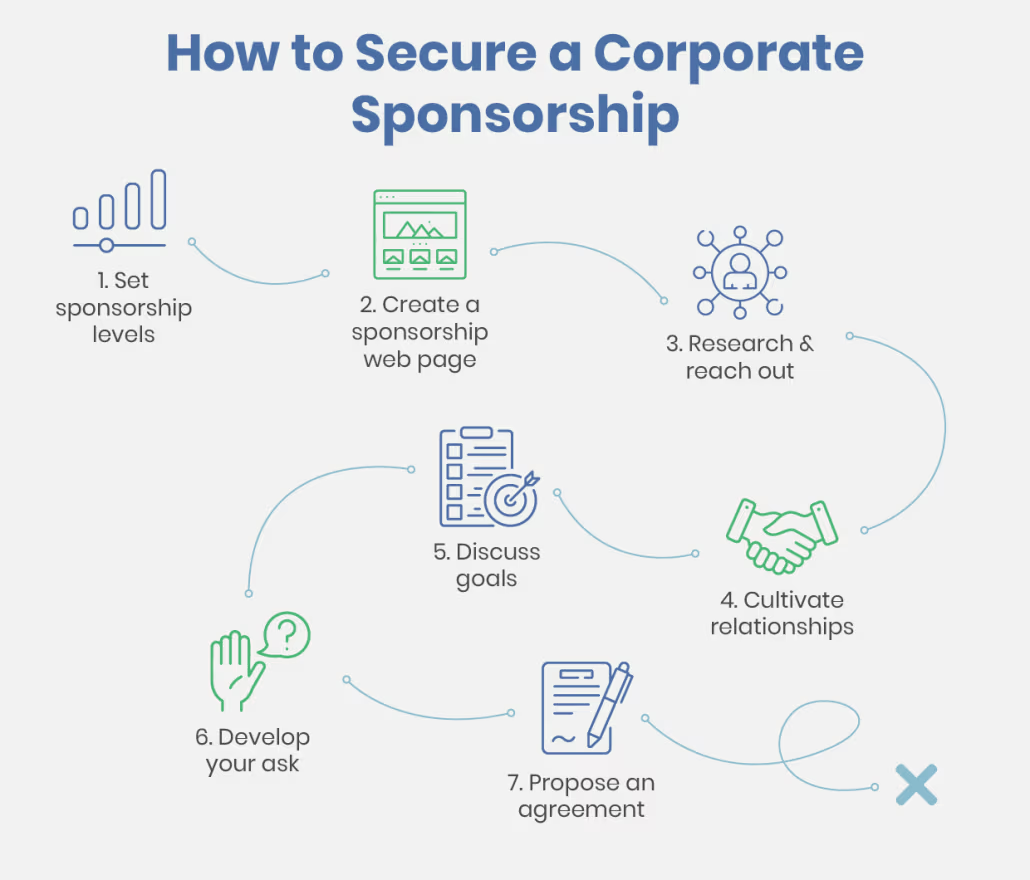
1. Set sponsorship levels
Before you ask for a corporate sponsorship, decide exactly what you’re looking for from sponsors. Most sponsorship agreements are negotiations, wherein your nonprofit agrees to promote the sponsor in exchange for monetary support. To start and streamline these conversations, prepare sponsorship levels.
Sponsorship levels are tiers that businesses can choose from to provide different amounts of support based on their financial capacity and level of interest. For example, you might set three different levels:
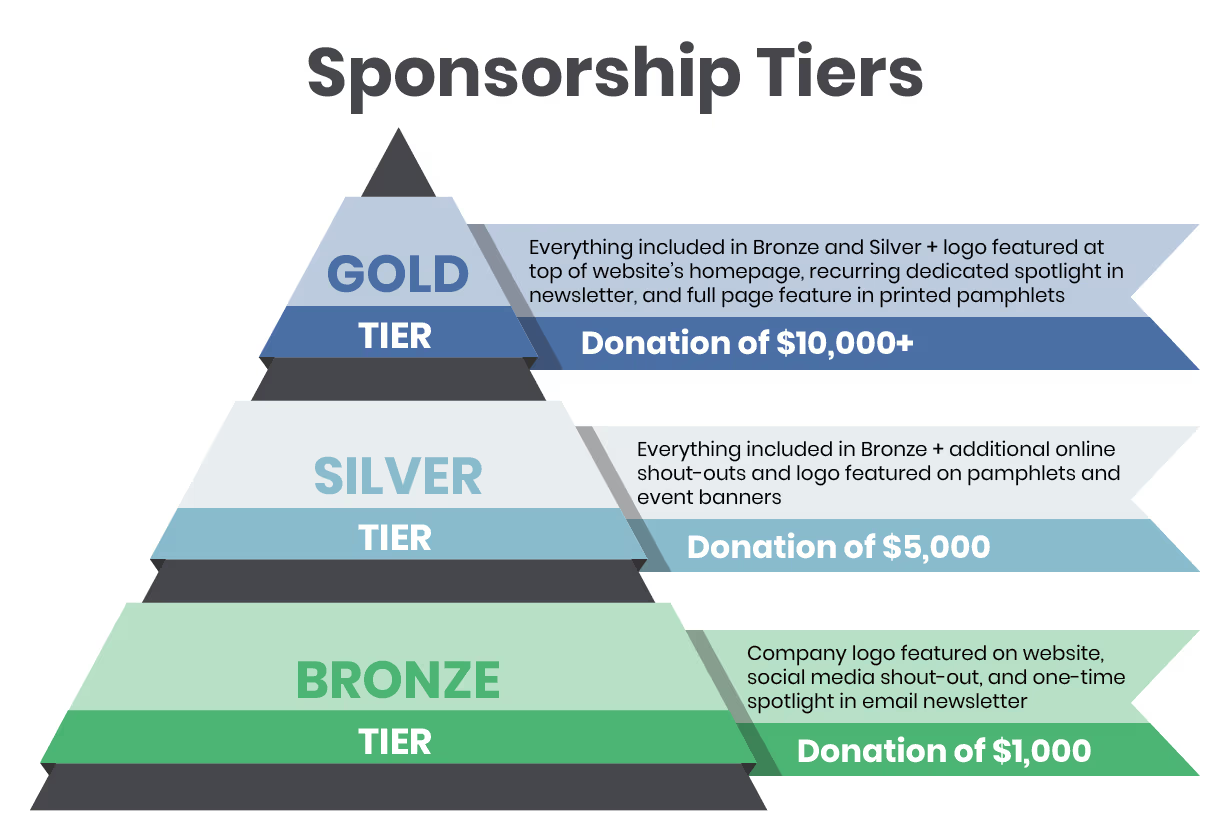
- A low-level sponsorship, valued at $1,000 – $5,000.
- A mid-tier sponsorship of $5,000 – $10,000.
- A major sponsorship valued over $10,000.
These levels are just a rough outline, and your nonprofit’s levels should be based on your specific needs. For example, during a capital campaign, you would likely have tiers with much higher donation values but also more significant rewards, like the right to name a specific building or program.
2. Create a sponsorship page on your website
Prospective donors go to your website to learn more information when deciding whether to donate to your cause and so do potential sponsors! To put your best foot forward, create a designated sponsorship page that includes essential information about what sponsoring your nonprofit looks like.
This page should include your case for support, sponsorship levels, and details about the benefits companies receive by partnering with your nonprofit. Additionally, don’t forget to include up-to-date contact information so businesses can reach out to you to start the sponsorship process.
When designing your website, consider potential sponsors as a new audience to consider, alongside donors and beneficiaries. Make sure your sponsorship page is easy to find on your website by including it in your navigation bar or footer and linking to it on your “ways to give” page.
3. Research and reach out to prospective sponsors
Now that you have your sponsorship page set up, you’re ready to research each of your prospective sponsors to identify the most promising candidates and prepare to meet with them.
At this point, you should have already researched the values and charitable histories of sponsors on your short list of candidates. Now, look for any additional insights that will help you craft your sponsorship appeals. Look deeper into:
- Each company’s audience
- Charitable organizations they have relationships with
- Their current CSR initiatives
If you can explain to a business that sponsoring your nonprofit will fit right in with their focus on helping uplifting grassroots movements related to fighting inequality, for example, you’ll be in a better position to secure their support. Consider each sponsor and how you can connect your mission to their philanthropic values.
Then, it’s time to make your initial introductions. Give each company a phone call or email them to set up a time to talk about your organization. You can either find this information online or conduct an email or phone append to locate accurate contact information. At this stage, you’re not asking anything yet, and instead just reaching out to see if they seem interested in your mission.
4. Cultivate relationships
Once you’ve done your initial outreach, start cultivating relationships with promising potential sponsors. At this stage, some businesses may be more interested than others, but it’s worthwhile to spend time meeting with each one to discuss your nonprofit’s mission in more detail. You can learn a lot about each business by having more than one introductory conversation.
If possible, have meetings in person so company representatives can get to know your nonprofit’s leadership personally. For example, you might ask if they’d like to have coffee with a board member or go out to dinner with your founder.
5. Discuss needs and goals
After getting to know prospects and gauging their interests, you can start discussing a sponsorship in earnest. Discuss the reason your nonprofit needs corporate sponsorships and what you hope to achieve with a sponsor’s help. Explain your specific needs and goals, such as needing advertising support to spread awareness of your cause and cultivate increased community action.
Ask businesses about their goals, as well. What goals guide their current CSR strategy? Do they want to engage more customers by supporting the causes they believe in? Explain how you could boost their brand awareness by associating their name and logo with your nonprofit’s mission.
6. Develop your sponsorship appeal
It’s time to hammer out the details and make a formal request to the businesses you think would be the best fit for a corporate sponsorship. In your sponsorship ask, make sure to include:
- Details about the specific project, program, or event the sponsorship will support.
- Your project’s budget and goals, including the monetary amount or in-kind donation items you need from the sponsor.
- What you’ll do for the sponsor, such as how you plan to promote their involvement in your marketing materials or event signage.
- How to take the next step if they’re ready to partner with your organization.
Additionally, reiterate anything you’ve discussed about why your nonprofit is a good fit for the business. Highlight your similar audiences and value alignment so they’re reminded of the mutual benefits your partnership will produce.
7. Propose a plan and agreement
Once a business responds yes to your ask, congratulations! You’ve secured a corporate sponsorship. But the work isn’t done quite yet. The final step is to agree with your new sponsor about what exactly the sponsorship will include.
Meet with your sponsor to work out the details of how the sponsorship will work, including each party’s goals and expectations. Outline exactly what the sponsor will provide and when, along with the concrete ways your nonprofit will recognize the support.
Depending on the sponsorship, this may involve creating and signing an official contract agreement. If this applies to your sponsorships, have your nonprofit’s lawyer create and review all materials you plan to present sponsors with.
Corporate Sponsorship Examples
Before seeking out a sponsorship, explore real-life examples to see what sponsorships look like in practice. Get inspired by these three examples to brainstorm ideas for how your nonprofit could leverage corporate support.
Nordstrom + Central Park Conservancy
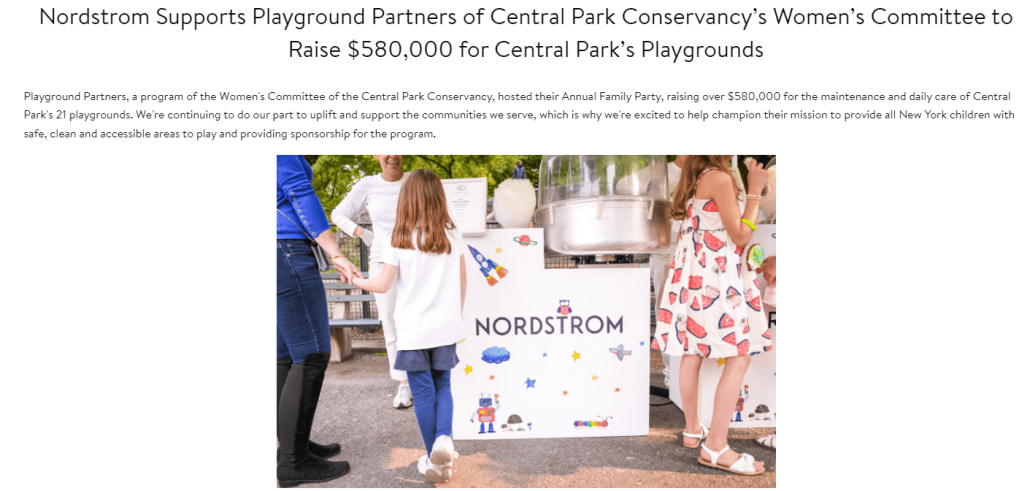
Clothing company Nordstrom provided its support to the nonprofit Women’s Committee of the Central Park Conservancy by sponsoring its Annual Family Party event. The family-friendly event featured fun activities and games for kids in Central Park in an effort to raise funds for the park’s playgrounds.
Thanks to Nordstrom’s sponsorship, the nonprofit was able to raise over $500,000 to support the maintenance and care of the playgrounds in Central Park.
Bank of America + Boys & Girls Clubs
The Bank of America Charitable Foundation has partnered with the Boys & Girls Clubs of America for decades, providing monetary support for the organization’s programs for at-risk youth. In recent years, Bank of America upgraded its support by sponsoring a program called Project Learn.
Bank of America provided a $1 million grant to sponsor Project Learn, which provides tutoring for children aged 6-18 across the country. The grant was divided between 10 local Boys & Girls Clubs that all primarily serve diverse communities.
Target + Nonprofits Across the US

Corporate sponsorships aren’t always restricted to a specific program or event. For instance, Target has sponsored multiple nonprofits with in-kind donations during the holiday season. The nationwide initiative was known as “The Great Giftogether,” during which Target stores across the country partnered with local nonprofits to identify families in need and provide them with donated holiday gifts.
Additional Corporate Philanthropy Resources
With these strategies and a motivated team, you have everything you need to find your perfect corporate match and secure a sponsorship. But don’t stop there! Beyond corporate sponsorships, you can leverage matching gifts at any time to double your donors’ gifts and dramatically increase your fundraising results.
To learn more about all the ways your nonprofit can tap into corporate philanthropy, check out these additional resources:
- Winning Workplace Giving Strategies & How to Leverage Them. Read up on the variety of ways you can supplement corporate sponsorships with other workplace giving opportunities.
- 40+ Matching Gift Companies: Find Your Match Today. Want a headstart on finding potential sponsors? Check out this list of companies that donate the most to nonprofits in matching gifts. Plus, they’re likely to invest in multiple types of philanthropy!
- How to Unlock Corporate Giving: The Key to Boost Donations. Discover more strategies for maximizing corporate support for your nonprofit via sponsorships, matching gifts, and more.

